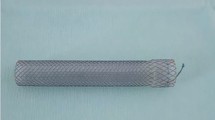Abstract
Introduction
Endoscopic dilation is the standard of care for stenoses of the cervical esophagus, but refractory strictures require some form of stenting. Most endoscopists avoid the placement of metal stents near the upper esophageal sphincter as they can cause major problems like severe cervical pain and globus sensation. We report our results with the use of biliary SEMS in the upper esophagus, which have a smaller diameter than regular esophageal stents and therefore exert less expansive force.
Material and methods
We retrospectively reviewed all patients in our center between July 2011 and June 2014 who received a biliary metal stent because of a refractory stricture in the cervical esophagus. We implanted biliary SEMS (Wallflex, Boston Scientific) with a diameter of 1 cm and length of 6–8 cm. Technical and clinical success, adverse events and duration of stenting were evaluated.
Results
Ten patients were treated with biliary SEMS in the upper esophagus. Strictures were located between 10 and 19 cm from incisor teeth. Stent placement was successful in all (10/10) patients. One stent had to be extracted because of pain and globus sensation. Apart from that stent tolerability was good. All remaining patients (9/9) reported improvement of dysphagia with a decrease in mean dysphagia score from 3.2 to 1.78. Mean duration of stenting was 68 days.
Discussion
Because of a high clinical success rate and good tolerability, biliary metal stents are a reasonable alternative for difficult strictures in the cervical esophagus, especially in the palliative setting.


Similar content being viewed by others
References
Eleftheriadis E, Kotzampassi K (2006) Endoprosthesis implantation at the pharyngo-esophageal level: problems, limitations and challenges. World J Gastroenterol 12:2103–2108
Ahlawat SK, Al-Kawas FH (2008) Endoscopic management of upper esophageal strictures after treatment of head and neck malignancy. Gastrointest Endosc 68:19–24
Lee SH (2001) The role of oesophageal stenting in the non-surgical management of oesophageal strictures. Br J Radiol 74:891–900
Gislason GT, Pasricha PJ (1997) Crossing the upper limit: esophageal stenting in the proximal esophagus. Dysphagia 12:84–85
Goldschmid S, Boyce HW Jr, Nord HJ, Brady PG (1988) Treatment of pharyngoesophageal stenosis by polyvinyl prosthesis. Am J Gastroenterol 83:513–518
Gallo A, Pagliuca G, de Vincentiis M, Martellucci S, Iallonardi E, Fanello G, Cereatti F, Fiocca F (2012) Endoscopic treatment of benign and malignant strictures of the cervical esophagus and hypopharynx. Ann Otol Rhinol Laryngol 121(2):104–109
Verschuur EM, Kuipers EJ, Siersema PD (2007) Esophageal stents for malignant strictures close to the upper esophageal sphincter. Gastrointest Endosc 66(6):1082–1090
Conio M, Blanchi S, Filiberti R, Repici A, Barbieri M, Bilardi C, Siersema PD (2007) A modified self-expanding Niti-S stent for the management of benign hypopharyngeal strictures. Gastrointest Endosc 65(4):714–720
Profili S, Meloni GB, Feo CF, Pischedda A, Bozzo C, Ginesu GC, Canalis GC (2002) Self-expandable metal stents in the management of cervical oesophageal and/or hypopharyngeal strictures. Clin Radiol 57(11):1028–1033
Somani SK, Verma N, Avasthi G, Ghosh A, Goyal R, Joshi N (2010) High pharyngoesophageal strictures after laryngopharyngectomy can also be treated by self-expandable plastic stents. Gastrointest Endosc 71(7):1304–1307
Disclosures
Drs. Bechtler, Wagner, Fuchs and Jacobs have no conflicts of interest or financial ties to disclose.
Author information
Authors and Affiliations
Corresponding author
Rights and permissions
About this article
Cite this article
Bechtler, M., Wagner, F., Fuchs, ES. et al. Biliary metal stents for proximal esophageal or hypopharyngeal strictures. Surg Endosc 29, 3205–3208 (2015). https://doi.org/10.1007/s00464-014-4061-1
Received:
Accepted:
Published:
Issue Date:
DOI: https://doi.org/10.1007/s00464-014-4061-1




